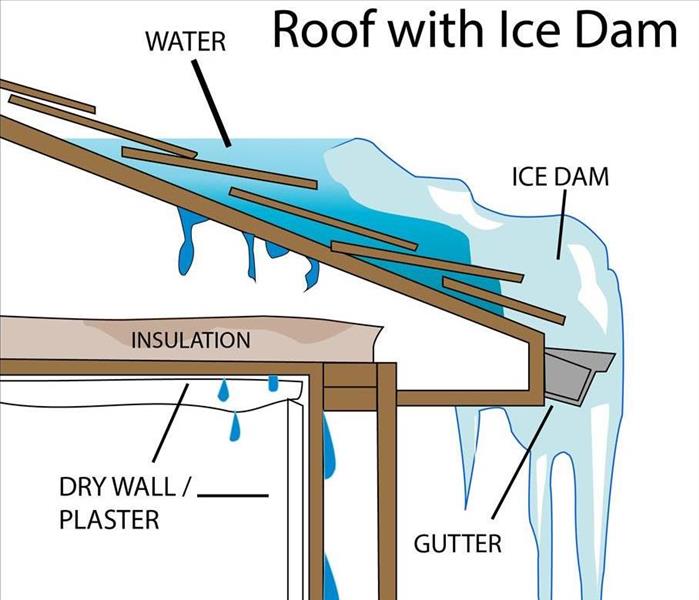Ice Damming... What is it?
1/23/2018 (Permalink)
An ice dam is an ice build-up on the eaves of sloped roofs of heated buildings that results from melting snow under a snow pack reaching the eave and freezing there. Freezing at the eave impedes the drainage of meltwater, which adds to the ice dam and causes backup of the meltwater in a manner, which may cause water leakage into the roof and consequent damage to the building and its contents if the water leaks through the roof.
Ice dams are a common sight in Northern states... not so common here in Tennessee. We've handled several claims this past month stemming from ice damming. What we've found is the flatter the pitch of the roof, the easier it is for an ice dam to get a grip. Gutters at the eaves can also trap snow and ice. If snow and ice build up high enough in the gutter, it can provide a foundation for an ice dam.
PREVENTING ICE DAMS
You can scrape snow from the roof whenever it falls, using a snow rake from below or a broom or plastic shovel from above. BE CAREFUL: The first method can bury you in snow, while the second can send you slipping off the roof. Hire someone who knows how to use a safety line.
You can replace your shingle roof with standing seam or other metal roof. Or you can replace the bottom three feet or so of your shingle roof with a wide metal drip edge. Whatever you do, install a water-repellent membrane under any new roofing.
NOTE: If your roof is not very steep, an ice dam can still form on metal roofing and drip edges.
DEALING WITH EXISTING ICE DAMS
1. Remove the ice dam by breaking it free in small chucks. Do NOT use an ax or other sharp tool! You’ll cut through the shingles. Instead, tap lightly with a blunt mallet. This is slow, dangerous work, so hire someone experienced at roofing. Even if you do it safely, the chunks of ice can take pieces of shingle with them.
2. Clear out gutters and downspouts. Again, this is ladder work and an easy way to damage either plastic or metal gutters and spouts.
3. Melt troughs through the ice dam with calcium chloride ice melter. Do NOT use rock salt! It will damage paint, metals, and plants beneath the eave and wherever the salty water drains.
A good trough-maker is a tube of cloth (a leg from an old pair of panty hose works well). Fill it with calcium chloride, tie off the top, and lay it vertically across the ice dam. It will slowly melt its way down through the dam, clearing a path for the underlying water to flow free.
WHAT DAMAGE DO ICE DAMS CAUSE?
When an ice dam gets big enough, melted water backs up behind it and seeps underneath the shingles. Eventually, it will drip into the insulation and down into the ceilings and exterior walls beneath the eave, ruining sheetrock and paint. If the ice dam breaks free, it can pull shingles and gutters off with it, and it will damage anything it falls on: shrubs, windowsills, cars, pets, and people. If the roof sheathing stays wet, it can form mildew and start to rot.
That's where we come into play. We can't prevent the ice damming from happening, but we can help you take care of the damages that it can cause.






 24/7 Emergency Service
24/7 Emergency Service
